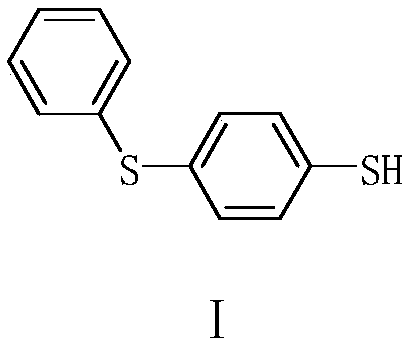Preparation method of 4-phenylmercaptothiophenol
A technology of thiophenylthiophenol and vulcanization reaction, which is applied in the field of preparation of 4-thiophenylthiophenol, can solve the problems of many 3-bromine rearrangement by-products, high substitution reaction temperature, cumbersome preparation process of vulcanization reagents, etc., to achieve The effects of avoiding bromine rearrangement by-products, low reaction temperature, and less production of three wastes
- Summary
- Abstract
- Description
- Claims
- Application Information
AI Technical Summary
Problems solved by technology
Method used
Image
Examples
Embodiment 1
[0056] Embodiment 1: Preparation of 4-bromodiphenyl sulfide (Ⅲ)
[0057] In the 1000 milliliter four-necked flask that is connected with stirring, thermometer, reflux condenser and dropping funnel, add 350 grams of dichloromethane, 37.2 grams (0.2 moles) of diphenyl sulfide, 41.0 grams (0.2 moles) of 40wt% hydrogen bromide Acid aqueous solution, keep internal temperature between 20-25°C, add dropwise 25.0 g (0.22 moles) of 30wt% hydrogen peroxide, dropwise complete in 1 hour, stir and react at 25-30°C for 2 hours. Stand to separate the layers, extract the water layer twice with dichloromethane, 20 grams each time, combine the dichloromethane layers, distill and recover the solvent dichloromethane, and distill under reduced pressure (110-125°C / 2-3mmHg) to obtain 51.6 grams 4-Bromodiphenylsulfide (Ⅲ), the yield is 97.4%, and the gas phase purity is 99.8%.
Embodiment 2
[0058] Embodiment 2: Preparation of 4-bromodiphenylsulfide (Ⅲ)
[0059] In the 1000 milliliter four-necked flask that is connected with stirring, thermometer, reflux condenser and dropping funnel, add 350 gram methylene dichloride, 37.2 gram (0.2 mole) diphenyl sulfide, 20.6 gram (0.2 mole) sodium bromide, 60.0 grams (0.12 moles) of 20wt% sulfuric acid aqueous solution, keep the internal temperature between 20-25 °C, add dropwise 27.5 grams (0.24 moles) of 30wt% hydrogen peroxide, add dropwise in 1 hour, drop it, and stir the reaction between 25-30 °C 2 hours. Stand to separate the layers, extract the water layer twice with dichloromethane, 20 grams each time, combine the dichloromethane layers, distill and recover the solvent dichloromethane, and distill under reduced pressure (110-125°C / 2-3mmHg) to obtain 51.2 grams 4-Bromodiphenylsulfide (Ⅲ), the yield is 96.6%, and the gas phase purity is 99.7%.
Embodiment 3
[0060] Embodiment 3: the preparation of 4-phenylmercaptothiophenol (Ⅰ)
[0061] Under nitrogen protection, 150 grams of tetrahydrofuran, 2.7 grams (0.11 moles) of magnesium powder, 0.5 grams of 1,2-dibromoethane, 1.5 grams of 4 prepared in Example 1 were added to a 500 milliliter four-necked flask equipped with a stirring and thermometer. -Bromodiphenyl sulfide (Ⅲ), 0.02 g of iodine, 40-45 ° C, 0.3 hours after initiation, drop 25.0 g (a total of 0.1 moles) of 4-bromodiphenyl prepared in Example 1 between 40-45 ° C The mixed solution of thioether (Ⅲ) and 100 g of tetrahydrofuran was dropped in 2 hours, and then stirred and reacted at 45-50° C. for 2 hours. Cool to 20-25°C, add 3.9 grams (0.12 moles) of sulfur, stir and react at 30-35°C for 3 hours, recover the solvent by distillation under reduced pressure, add 50 grams of water, 150 grams of dichloromethane to the residue, and use 20wt% sulfuric acid The pH value of the acidification system is 2.0-3.0, and the layers are sepa...
PUM
 Login to View More
Login to View More Abstract
Description
Claims
Application Information
 Login to View More
Login to View More - R&D
- Intellectual Property
- Life Sciences
- Materials
- Tech Scout
- Unparalleled Data Quality
- Higher Quality Content
- 60% Fewer Hallucinations
Browse by: Latest US Patents, China's latest patents, Technical Efficacy Thesaurus, Application Domain, Technology Topic, Popular Technical Reports.
© 2025 PatSnap. All rights reserved.Legal|Privacy policy|Modern Slavery Act Transparency Statement|Sitemap|About US| Contact US: help@patsnap.com



